
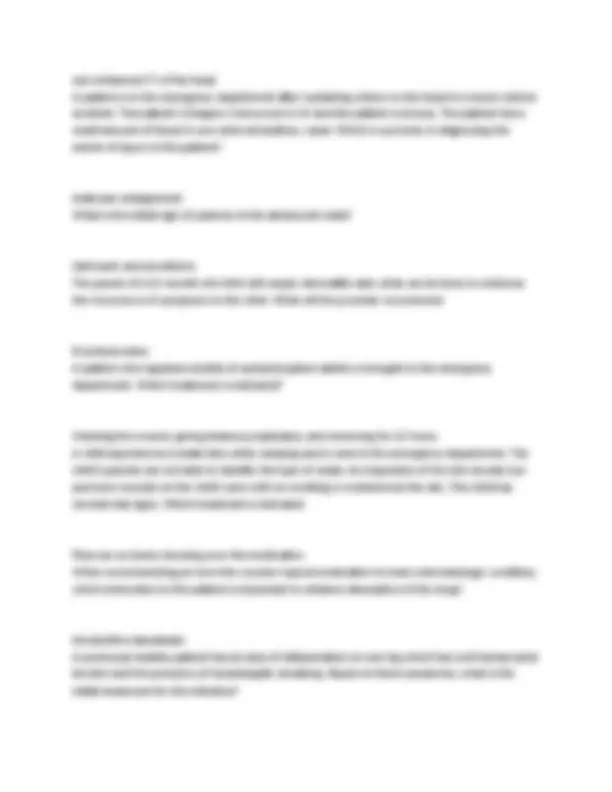
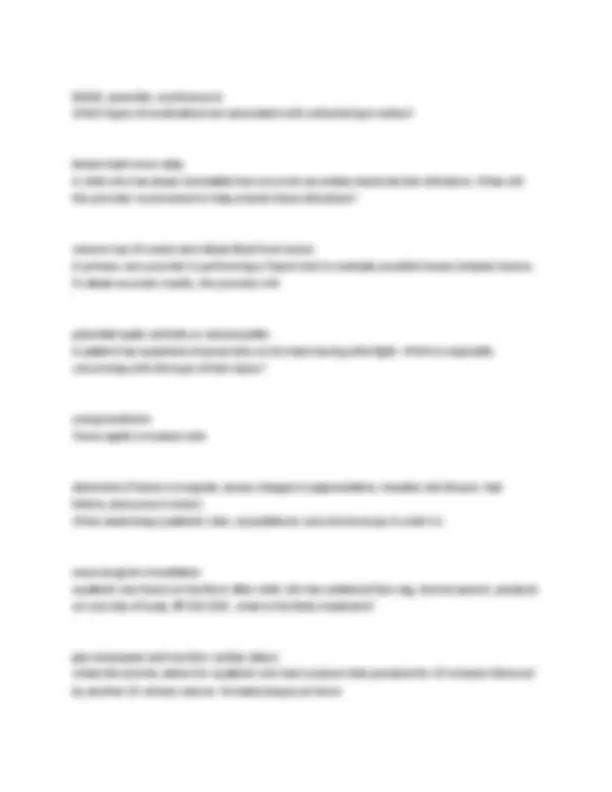
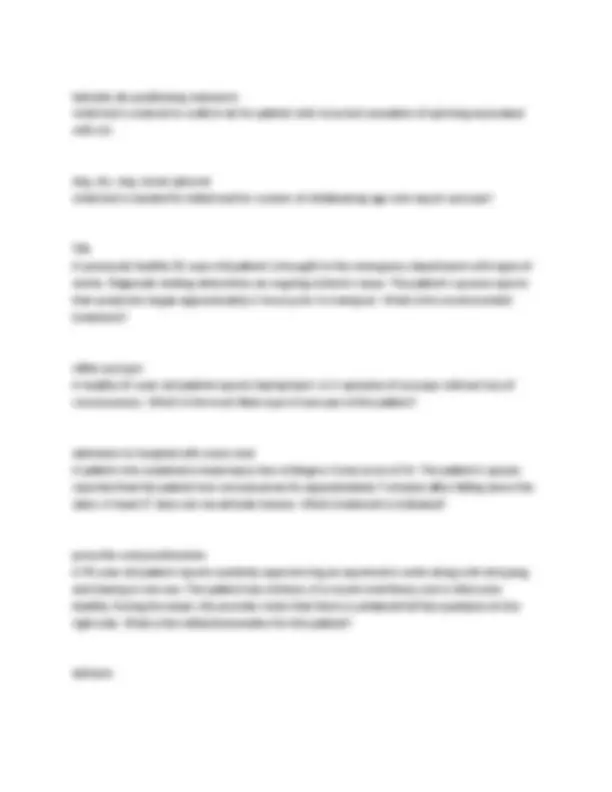
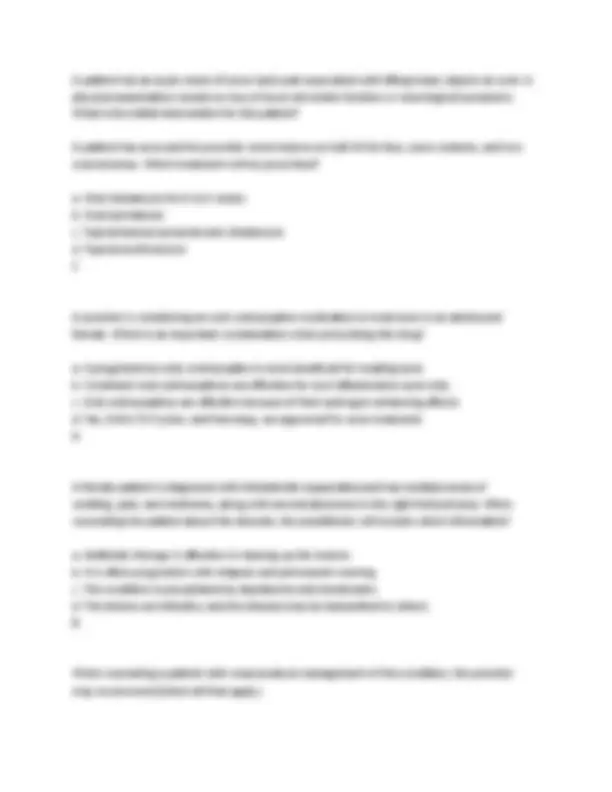
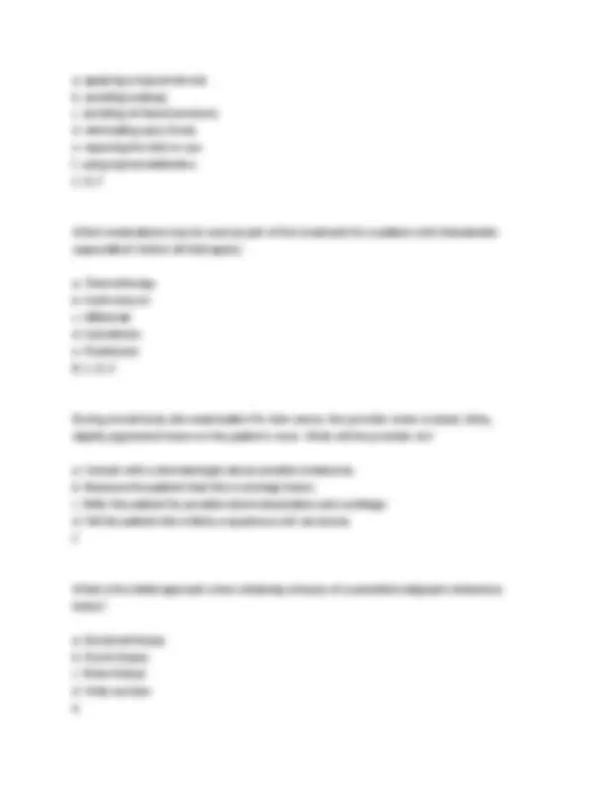
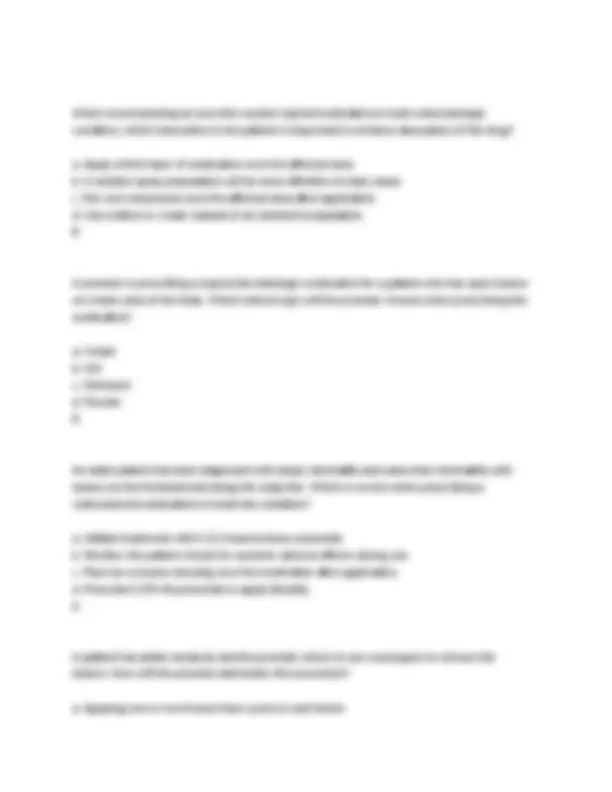
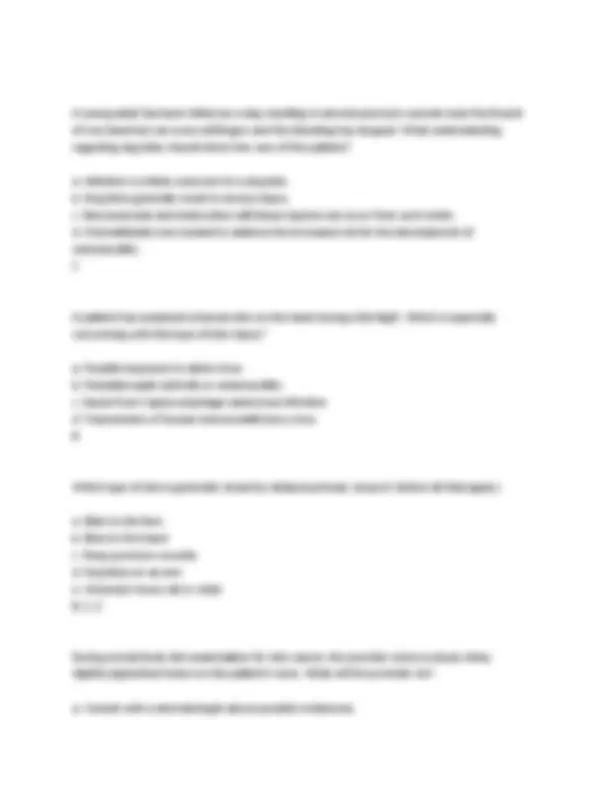
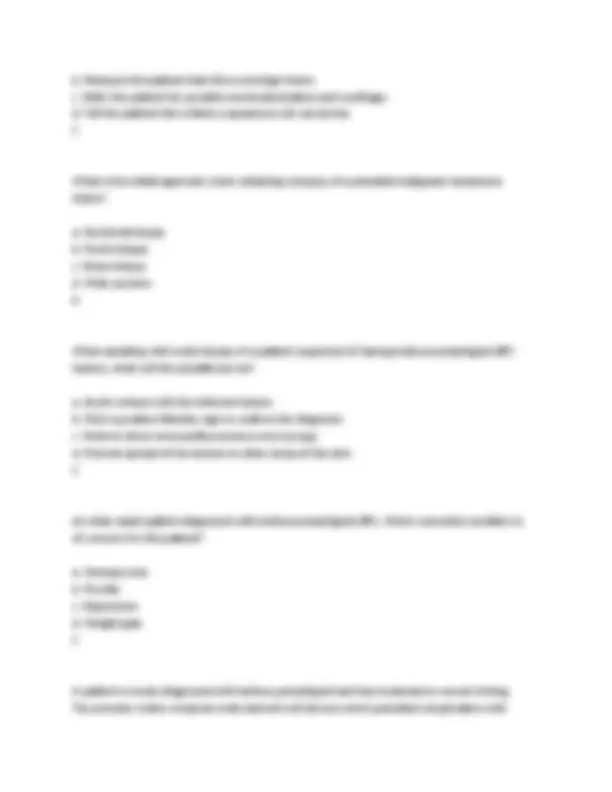
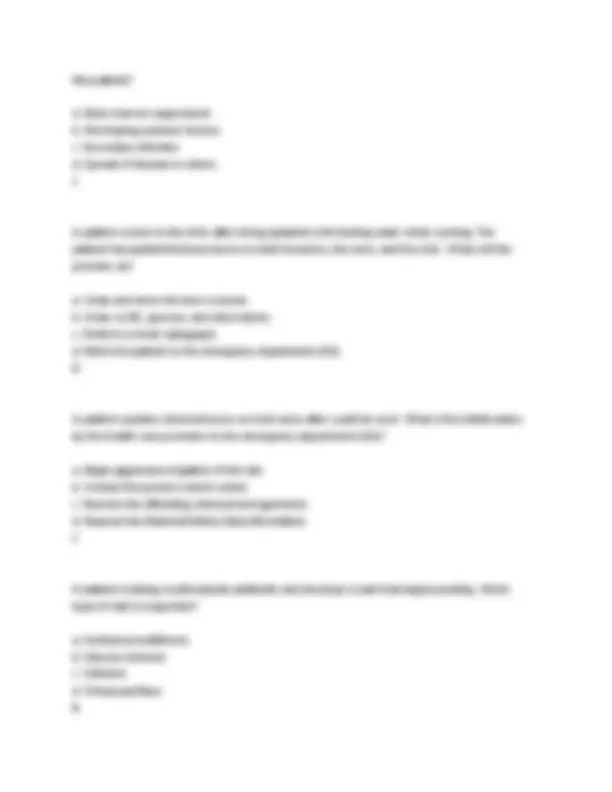
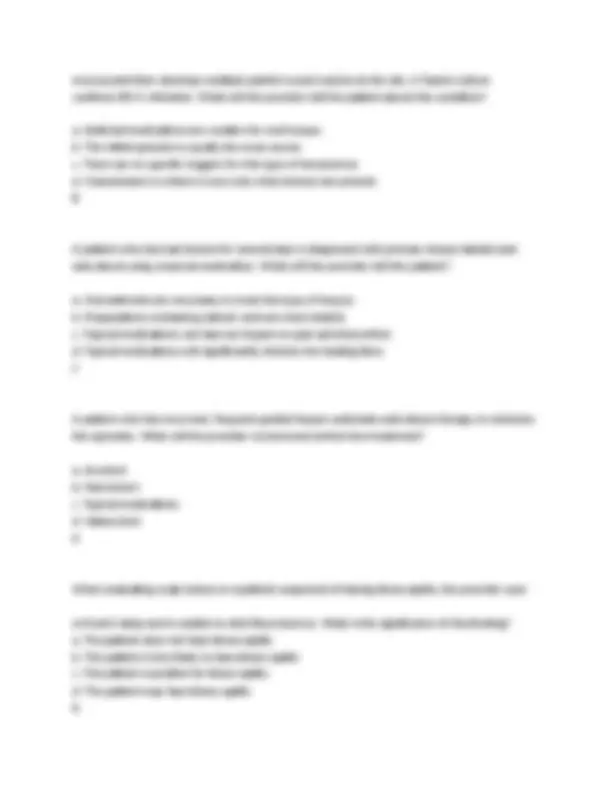
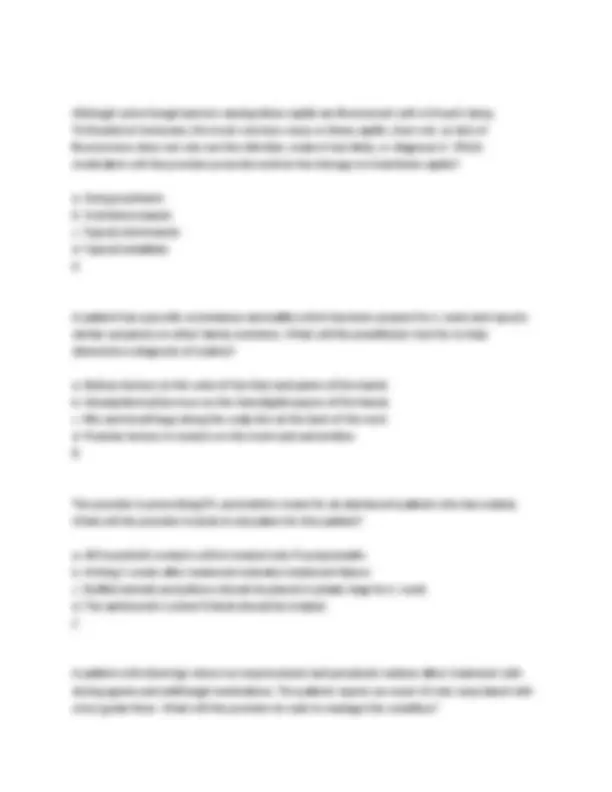
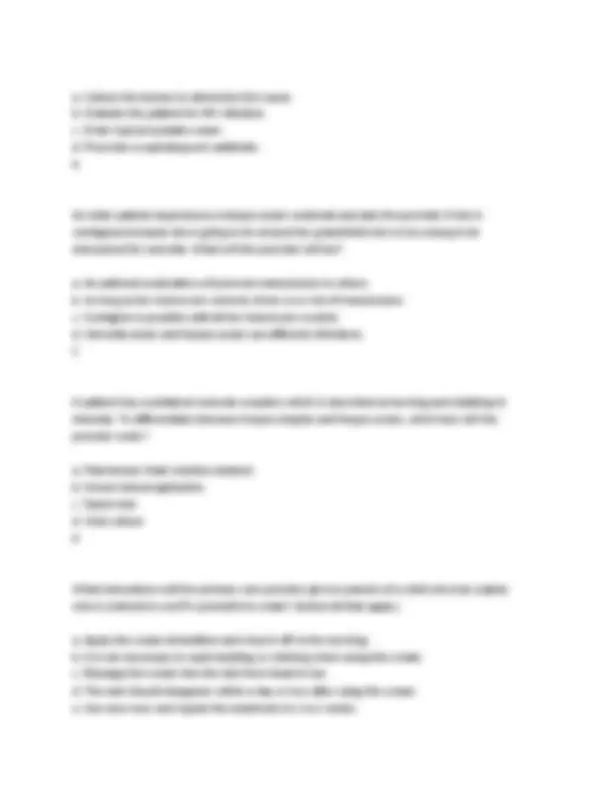
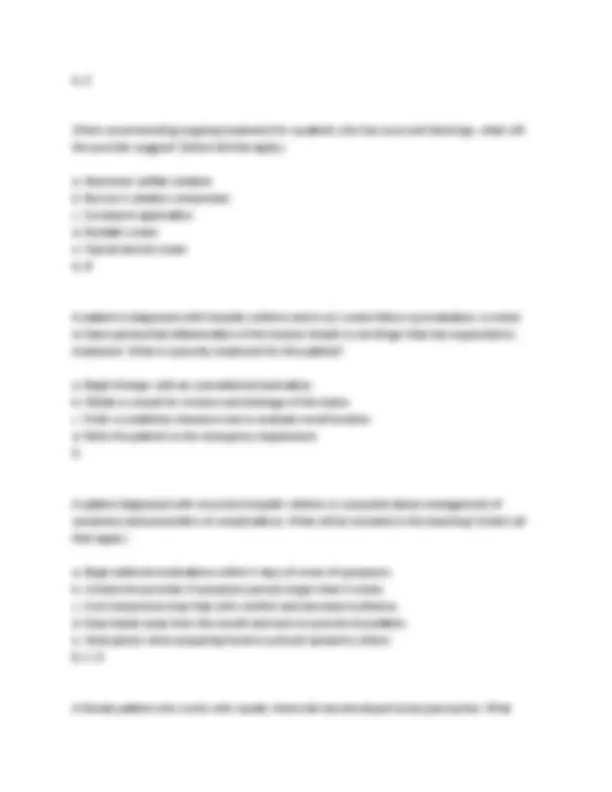
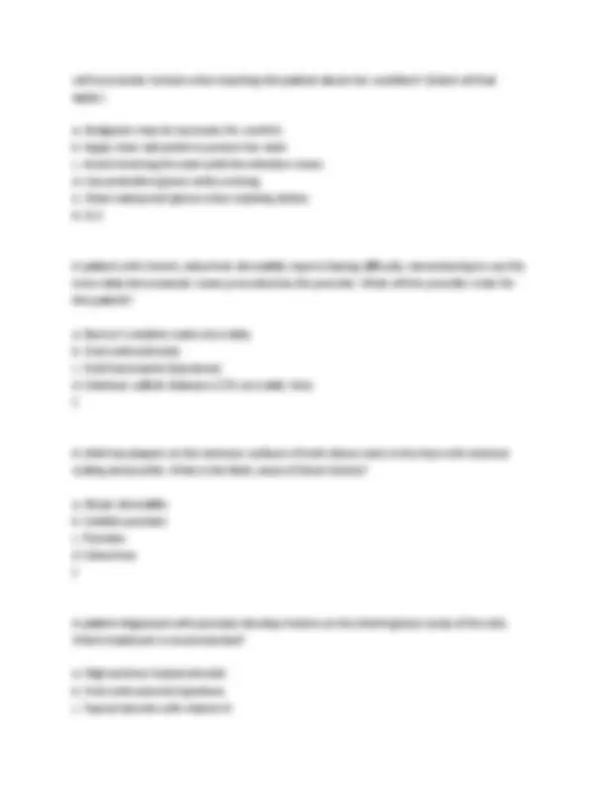
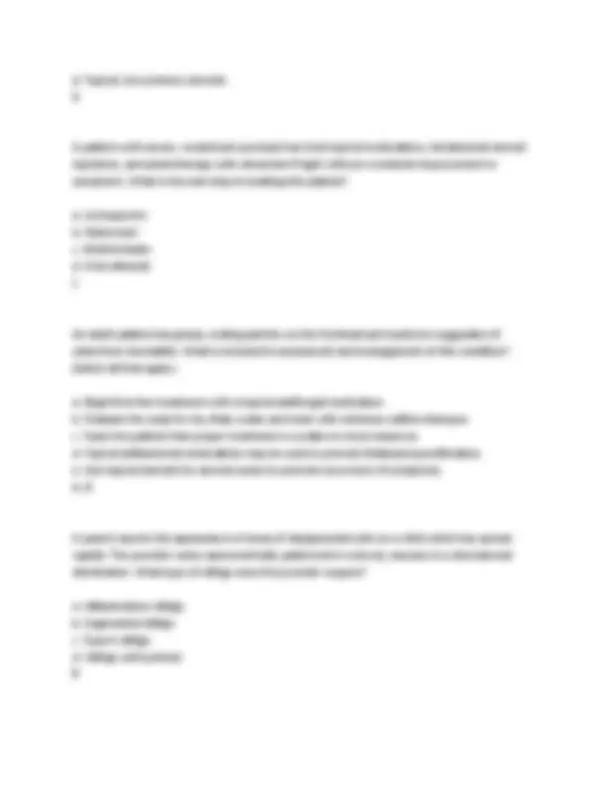
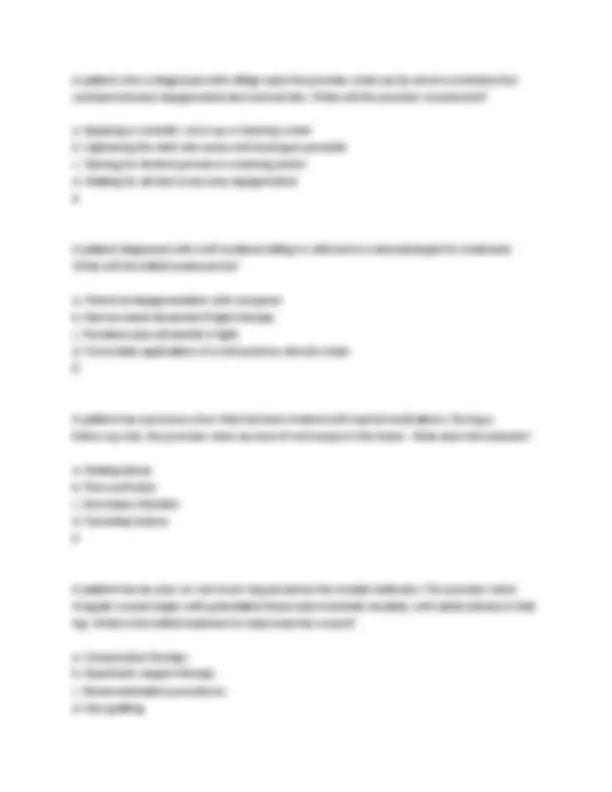
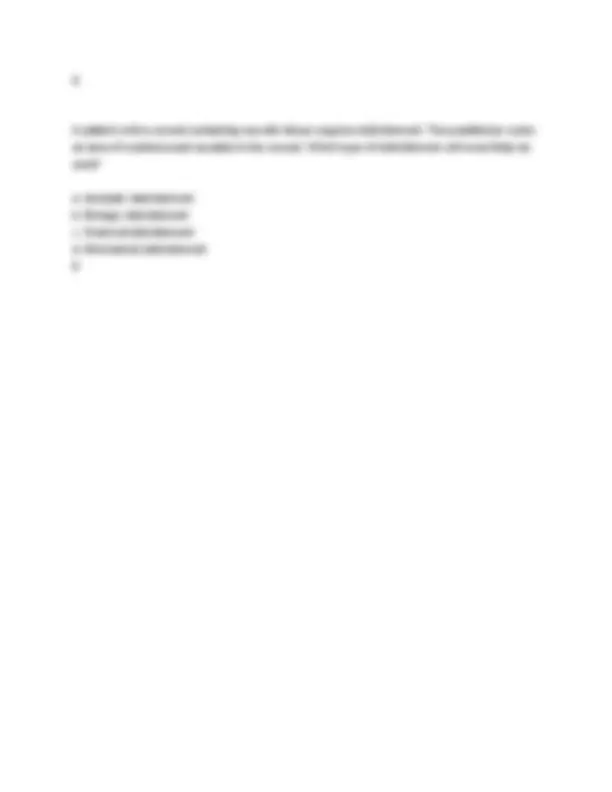


Study with the several resources on Docsity

Earn points by helping other students or get them with a premium plan


Prepare for your exams
Study with the several resources on Docsity

Earn points to download
Earn points by helping other students or get them with a premium plan
Community
Ask the community for help and clear up your study doubts
Discover the best universities in your country according to Docsity users
Free resources
Download our free guides on studying techniques, anxiety management strategies, and thesis advice from Docsity tutors
N675 Final Exam questions and answers inflammatory bursitis An examiner is evaluating a patient who reports unilateral shoulder pain and notes limited active and passive range of motion in the affected shoulder along with erythema and bulging on the anterior shoulder. What diagnosis is likely with this presentation? Anterior drawer test Which maneuver during a physical examination is used to assess the anterior cruciate ligament? gabapentin A patient has chronic radicular neck pain that no longer responds to over-the-counter NSAIDs and physical therapy measures and reports having difficulty sleeping. Which medication will the provider order?
Typology: Exams
1 / 25

This page cannot be seen from the preview
Don't miss anything!


















inflammatory bursitis An examiner is evaluating a patient who reports unilateral shoulder pain and notes limited active and passive range of motion in the affected shoulder along with erythema and bulging on the anterior shoulder. What diagnosis is likely with this presentation? Anterior drawer test Which maneuver during a physical examination is used to assess the anterior cruciate ligament? gabapentin A patient has chronic radicular neck pain that no longer responds to over-the-counter NSAIDs and physical therapy measures and reports having difficulty sleeping. Which medication will the provider order? Asking the patient to perform the Valsalva maneuver A patient reports severe back pain located in the lumbar spine. To evaluate whether the patient has axial pain or radicular pain, which assessment is necessary? Conservative management with RICE and activity modification A previously healthy patient reports a sensation of one knee locking or feeling like it will give way when descending stairs. The patient has no recollection of injury to the knee and denies pain. What is the most likely treatment for this disorder? aerobic exercise A 45-year-old patient has mild osteoarthritis in both knees and asks about non-pharmacologic therapies. What will the provider recommend? Treatment with a nonsteroidal anti-inflammatory drug
A patient has an acute onset of lower back pain associated with lifting heavy objects at work. A physical examination reveals no loss of lower extremity function or neurological symptoms. What is the initial intervention for this patient? electromyography, nerve conduction studies A patient has symptoms of carpal tunnel syndrome. Which diagnostic tests will help confirm this disorder? (Select all that apply.) RICE, activity modification and bracing, NSAID What are included in the initial management of bursitis of the heel? medial epicondylitis A patient reports elbow pain and the examiner elicits pain with resisted wrist flexion, forearm pronation, and passive wrist extension on the affected side. What is a likely cause of this pain? Tetanus prophylaxis, CBC BUN electrolytes and creatinine, coagulation studies A patient is seen in the emergency department after experiencing a spider bite. The spider is in a jar and is less than one inch in size, yellow-brown, and has a violin-shaped marking on its back. Depending on the patient's symptoms, which treatments and diagnostic evaluations may be ordered? atopic dermatitis Which is the primary symptom causing discomfort in patients with atopic dermatitis arguing with parent Which behavior is most characteristic of early adolescence? containing the exposure What is the first priority in emergency management of a biological terrorism attack
NSAID, penicillin, erythromycin Which types of medications are associated with urticarial type rashes? bleach bath twice daily A child who has atopic dermatitis has recurrent secondary bacterial skin infections. What will the provider recommend to help prevent these infections? remove top of vesicle and obtain fluid from lesion A primary care provider is performing a Tzanck test to evaluate possible herpes simplex lesions. To attain accurate results, the provider will potential septic arthritis or osteomyelitis A patient has sustained a human bite on his hand during a fist fight. Which is especially concerning with this type of bite injury? oral griseofulvin Tinea capitis is treated with determine if lesion is irregular, assess changes in pigmentation, visualize skin fissure, hair follicle, and pores in lesion When examining a patient's skin, a practitioner uses dermoscopy in order to neurosurgical consultation a patient was found on the floor after a fall. she has unilateral face sag, slurred speech, paralysis on one side of body, BP 220/190. what is the likely treatment? give lorazepam and monitor cardiac status whats the priority action for a patient who had a seizure that persisted for 15 minutes followed by another 15 minute seizure. He takes keepra at home
hall pike dix positioning maneuver what test is ordered to confirm dx for patient with recurrent sensation of spinning associated with n/v ekg, cbc, eeg, serum glucose what test is needed for initial eval for women of childbearing age who report syncope? TPA A previously healthy 30-year-old patient is brought to the emergency department with signs of stroke. Diagnostic testing determines an ongoing ischemic cause. The patient's spouse reports that symptoms began approximately 2 hours prior to transport. What is the recommended treatment? reflex syncope A healthy 20-year-old patient reports having had 1 or 2 episodes of syncope without loss of consciousness. Which is the most likely type of syncope in this patient? admission to hospital with neuro eval A patient who sustained a head injury has a Glasgow Coma score of 14. The patient's spouse reported that the patient lost consciousness for approximately 7 minutes after falling down the stairs. A head CT does not reveal brain lesions. Which treatment is indicated? prescribe oral prednisolone A 35-year-old patient reports suddenly experiencing an asymmetric smile along with drooping and tearing in one eye. The patient has a history of a recent viral illness, but is otherwise healthy. During the exam, the provider notes that there is unilateral full face paralysis on the right side. What is the initial intervention for this patient? delirium
eat soups, take tepid water bath, fragrance free detergent When counseling a patient who has dry skin about ways to minimize exacerbations, what will the provider include ankle sprain with poss fracture A patient injures an ankle while playing soccer and reports rolling the foot inward while falling with immediate pain and swelling of the lateral part of the joint. The patient is able to bear weight and denies hearing an audible sound at the time of injury. What does this history indicate refer to interventional spine A patient has recurrent lumbar pain which is sometimes severe. The patient reports that prescription NSAIDs are no longer effective for pain relief. What will the provider recommen avoid high impact activity A patient has pain on the plantar aspect of the heel with weight bearing after rest. The pain is worsened with dorsiflexion of the foot. What is the initial treatment for this patient Admit to the hospital for intravenous antibiotics A patient with shoulder pain is seen by an orthopedic specialist who notes erythema, warmth, and fluctuance of the shoulder joint. What is the next step in treatment for this patient elastic bandage for compression, moist heat therapy if muscle spasm, cloth between ice pack and skin An emergency department provider is giving instructions for rest, ice, compression, and elevation (RICE) treatment in a patient with a sprain. What is included in teaching about this home care? plain radiograph to evaluate extent of injury
A patient has an acute onset of lower back pain associated with lifting heavy objects at work. A physical examination reveals no loss of lower extremity function or neurological symptoms. What is the initial intervention for this patient? A patient has acne and the provider notes lesions on half of the face, some nodules, and two scarred areas. Which treatment will be prescribed? a. Oral clindamycin for 6 to 8 weeks b. Oral isotretinoin c. Topical benzoyl peroxide and clindamycin d. Topical erythromycin C A provider is considering an oral contraceptive medication to treat acne in an adolescent female. Which is an important consideration when prescribing this drug? a. A progesterone-only contraceptive is most beneficial for treating acne. b. Combined oral contraceptives are effective for non-inflammatory acne only. c. Oral contraceptives are effective because of their androgen enhancing effects. d. Yaz, Ortho Tri-Cyclen, and Estrostep, are approved for acne treatment. D A female patient is diagnosed with hidradenitis suppurativa and has multiple areas of swelling, pain, and erythema, along with several abscesses in the right femoral area. When counseling the patient about this disorder, the practitioner will include which information? a. Antibiotic therapy is effective in clearing up the lesions. b. It is often progressive with relapses and permanent scarring. c. The condition is precipitated by depilatories and deodorants. d. The lesions are infective, and the disease may be transmitted to others. B When counseling a patient with rosacea about management of this condition, the provider may recommend (Select all that apply.)
When recommending an over-the-counter topical medication to treat a dermatologic condition, which instruction to the patient is important to enhance absorption of the drug? a. Apply a thick layer of medication over the affected area. b. A solution spray preparation will be more effective on hairy areas. c. Put cool compresses over the affected area after application. d. Use a lotion or cream instead of an ointment preparation. B A provider is prescribing a topical dermatologic medication for a patient who has open lesions on a hairy area of the body. Which vehicle type will the provider choose when prescribing this medication? a. Cream b. Gel c. Ointment d. Powder B An adult patient has been diagnosed with atopic dermatitis and seborrheic dermatitis with lesions on the forehead and along the scalp line. Which is correct when prescribing a corticosteroid medication to treat this condition? a. Initiate treatment with 0.1% triamcinolone acetonide. b. Monitor the patient closely for systemic adverse effects during use. c. Place an occlusive dressing over the medication after application. d. Prescribe 0.05% fluocinonide to apply liberally. A A patient has actinic keratosis and the provider elects to use cryosurgery to remove the lesions. How will the provider administer this procedure? a. Applying one or two freeze-thaw cycles to each lesion
b. Applying two or more freeze-thaw cycles to each lesion c. Applying until the freeze spreads laterally 1 mm from the lesion edges d. Applying until the freeze spreads laterally 4 mm from the lesion edges A A provider is preparing to administer electrocautery to a patient who has several seborrheic keratoses. The patient tells the provider that he has a pacemaker. Which action is correct? a. Administer the electrocautery per the usual protocol. b. Apply electrocautery in short burst at low voltage. c. Refer the patient to a dermatologist for removal. d. Suggest another method for removal of the lesions B Which type of office surgical procedure warrants sterile technique? a. Curettage b. Punch biopsy c. Scissor excision d. Shave biopsy B A primary care provider is performing a Tzanck test to evaluate possible herpes simplex lesions. To attain accurate results, the provider will perform what intervention? a. Blanch the lesions while examining them with a magnifying glass. b. Gently scrape the lesions with a scalpel onto a slide. c. Perform a gram stain of exudate from the lesions. d. Remove the top of the vesicles and obtain fluid from the lesions D When examining a patient's skin, a practitioner uses dermoscopy for what purpose? (Select all that apply.)
A young adult has been bitten by a dog resulting in several puncture wounds near the thumb of one hand but can move all fingers and the bleeding has stopped. What understanding regarding dog bites should direct the care of this patient? a. Infection is a likely outcome for a dog bite. b. Dog bites generally result in serious injury. c. Neurovascular and destructive soft tissue injuries can occur from such a bite. d. Oral antibiotics are needed to address the increased risk for the development of osteomyelitis. C A patient has sustained a human bite on the hand during a fist fight. Which is especially concerning with this type of bite injury? a. Possible exposure to rabies virus b. Potential septic arthritis or osteomyelitis c. Sepsis from Capnocytophaga canimorsus infection d. Transmission of human immunodeficiency virus B Which type of bite is generally closed by delayed primary closure? (Select all that apply.) a. Bites to the face b. Bites to the hand c. Deep puncture wounds d. Dog bites on an arm e. Wounds 6 hours old or older B, C, E During a total body skin examination for skin cancer, the provider notes a raised, shiny, slightly pigmented lesion on the patient's nose. What will the provider do? a. Consult with a dermatologist about possible melanoma.
b. Reassure the patient that this is a benign lesion. c. Refer the patient for possible electrodessication and curettage. d. Tell the patient this is likely a squamous cell carcinoma. C What is the initial approach when obtaining a biopsy of a potential malignant melanoma lesion? a. Excisional biopsy b. Punch biopsy c. Shave biopsy d. Wide excision A When assisting with a skin biopsy of a patient suspected of having bullous pemphigoid (BP) lesions, what will the practitioner do? a. Avoid contact with the infected lesions. b. Elicit a positive Nikolsky sign to confirm the diagnosis. c. Perform direct immunofluorescence microscopy. d. Prevent spread of the lesions to other areas of the skin. C An older adult patient diagnosed with bullous pemphigoid (BP). Which comorbid condition is of concern for this patient? a. Osteoporosis b. Pruritis c. Depression d. Weight gain C A patient is newly diagnosed with bullous pemphigoid and has moderate to severe itching. The provider orders a topical corticosteroid will discuss which potential complication with
Which medication classifications are associated with increasing the risk of developing acute generalized exanthematous pustulosis (AGEP) (Select all that apply.) a. Cephalosporins b. Calcium channel blockers c. Aminopenicillins d. Tuberculostatic agents e. Non-steroidal anti-inflammatory drugs (NSAIDS) B, C, E Which is the primary symptom causing discomfort in patients with atopic dermatitis (AD)? a. Dryness b. Erythema c. Lichenification d. Pruritis D A patient diagnosed with atopic dermatitis asks what can be done to minimize the recurrence of symptoms. What will the provider recommend? a. Calcineurin inhibitors b. Lubricants and emollients c. Oral diphenhydramine d. Prophylactic topical steroids B A patient who has atopic dermatitis has recurrent secondary bacterial skin infections. What will the provider recommend to help prevent these infections? a. Bleach baths twice weekly b. Frequent bathing with soap and water c. Low-dose oral antibiotics
d. Topical antibiotic ointments A A previously healthy patient has an area of inflammation on one leg which has well-demarcated borders and the presence of lymphangitic streaking. Based on these symptoms, what is the initial treatment for this infection? a. Amoxicillin-clavulanate b. Clindamycin c. Doxycycline d. Sulfamethoxazole-trimethoprim A A patient has vesiculopustular lesions around the nose and mouth with areas of honey-colored crusts. The provider notes a few similar lesions on the patient's hands and legs. Which treatment is appropriate for this patient? a. Mupirocin, 2% ointment b. Culture and sensitivity of the lesions c. Sulfamethoxazole-trimethoprim d. Surgical referral A A patient with a purulent skin and soft tissue infection (SSTI). A history reveals a previous MRSA infection in a family member. The clinician performs an incision and drainage of the lesion and sends a sample to the lab for culture. What is the next step in treating this patient? a. Apply moist heat until symptoms resolve. b. Begin treatment with amoxicillin-clavulanate. c. Prescribe trimethoprim-sulfamethoxazole. d. Wait for culture results before ordering an antibiotic. C A patient who has never had an outbreak of oral lesions reports a burning sensation on the oral
Although some fungal species causing tinea capitis are fluorescent with a Wood's lamp, Trichophyton tonsurans, the most common cause or tinea capitis, does not, so lack of fluorescence does not rule out the infection, make it less likely, or diagnose it. Which medication will the provider prescribe as first-line therapy to treat tinea capitis? a. Oral griseofulvin b. Oral ketoconazole c. Topical clotrimazole d. Topical tolnaftate A A patient has a pruritic eczematous dermatitis which has been present for 1 week and reports similar symptoms in other family members. What will the practitioner look for to help determine a diagnosis of scabies? a. Bullous lesions on the soles of the feet and palms of the hands b. Intraepidermal burrows on the interdigital spaces of the hands c. Nits and small bugs along the scalp line at the back of the neck d. Pustular lesions in clusters on the trunk and extremities B The provider is prescribing 5% permethrin cream for an adolescent patient who has scabies. What will the provider include in education for this patient? a. All household contacts will be treated only if symptomatic. b. Itching 2 weeks after treatment indicates treatment failure. c. Stuffed animals and pillows should be placed in plastic bags for 1 week. d. The adolescent's school friends should be treated. C A patient with intertrigo shows no improvement and persistent redness after treatment with drying agents and antifungal medications. The patient reports an onset of odor associated with a low-grade fever. What will the provider do next to manage this condition?
a. Culture the lesions to determine the cause. b. Evaluate the patient for HIV infection. c. Order topical nystatin cream. d. Prescribe a cephalosporin antibiotic. A An older patient experiences a herpes zoster outbreak and asks the provider if she is contagious because she is going to be around her grandchild who is too young to be immunized for varicella. What will the provider tell her? a. An antiviral medication will prevent transmission to others. b. As long as her lesions are covered, there is no risk of transmission. c. Contagion is possible until all her lesions are crusted. d. Varicella-zoster and herpes zoster are different infections. C A patient has a unilateral vesicular eruption which is described as burning and stabbing in intensity. To differentiate between herpes simplex and herpes zoster, which test will the provider order? a. Polymerase chain reaction analysis b. Serum immunoglobulins c. Tzanck test d. Viral culture A What instructions will the primary care provider give to parents of a child who has scabies who is ordered to use 5% permethrin cream? (Select all that apply.) a. Apply the cream at bedtime and rinse it off in the morning. b. It is not necessary to wash bedding or clothing when using this cream. c. Massage the cream into the skin from head to toe. d. The rash should disappear within a day or two after using the cream. e. Use once now and repeat the treatment in 1 to 2 weeks.